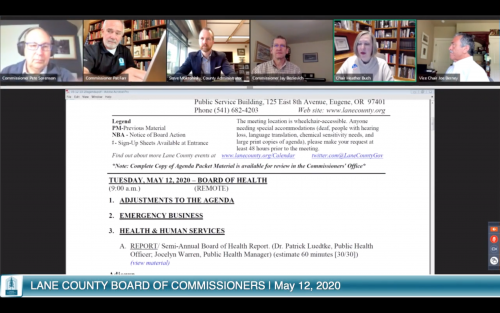
According to the semi-annual report from the Lane County Board of Health, there has been a decline in mental health among youth, as well as people of color, in Lane and Benton counties. Board of Commissioners Vice Chair Joe Berney calls the statistics presented “exceedingly depressing.” And the board discussed the implications of mental health and poverty issues in COVID-19.
On Tuesday, May 12, the Lane County Board of County Commissioners conducted their weekly public meeting via Zoom. During this meeting, epidemiologist Jennifer Webster from the Lane County Board of Health presented its semi-annual report.
Webster spoke about the data the Health Department is monitoring while looking towards reopening the county. That data includes examining whether there are significant increases in the number of COVID-19 cases, the number of people hospitalized for similar symptoms and significant outbreaks in individual communities.
Webster then moved on to discuss data about mental health in youth and people of color in Lane and Benton counties.
According to a 2013-2017 study from the Oregon Healthy Teens Survey, there has been a decline in mental health among youth. In 2013, 80 percent of 8th graders and 83 percent of 11th graders responded that their mental and emotional health was good or excellent. In 2017, those numbers dropped — only 70 percent of 8th graders and 63 percent of 11th graders responded having good or excellent mental/emotional health.
Next, Webster detailed two more surveys, which she says shows “persistent and avoidable disparities in Lane County based on race/ethnicity.”
The American Community Survey shows the percent of Lane County living in poverty by race from 2013-2017. The numbers presented that 17.3 percent of white people live in poverty, 22 percent of people of Hispanic or Latino origin, 29.9 percent for people who have two or more races, 25.2 percent for Native American or Alaska Native people, 28.6 percent for Black people, and the largest number of people living in poverty in Lane County is Asian people at 33.7 percent.
Webster also discussed a 2017 survey by the Oregon Behavior Risk Factor Surveillance System. It shows how people of different races reported their general health as fair or poor. Those numbers showed that 16.80 percent of white people reported having fair or poor general health, 27.60 percent of people of Hispanic or Latino origin, 12.7 percent for Asian people and 22.40 percent for Black people, and the largest number of people living in poverty in Lane County is Native American people at 30.20 percent.
“COVID-19 has magnified and placed front and center the social determinants of health that already create poor health outcomes for Lane County residents,” Webster said after presenting the data. “The pandemic has put increased financial pressure on a community where many residents were already in a precarious place, it has strained the mental health of a community that has already been experiencing a decline in mental wellness, and the burden of disease has disproportionately fallen on those populations already experiencing burden due to structural and historical discrimination based on race and ethnicity.”
Board of Commissioners Vice Chair Joe Berney responded to this, saying he found the statistics “exceedingly depressing.” He added, “Sadly it looks as if there’s an undeniable connection between race and class, which is not the world I’ve been trying to create all my life.”
According to Webster, there are three questions the Board of Health and Human Services are currently asking themselves: “How do we ensure all people in Lane County have the resources they need to live a healthy life? How do we create community conditions that support mental wellness and healthy behaviors for all Lane County residents? How do we ensure that Lane County is a place where resources are distributed equitably?”
These meetings are open to the public every Tuesday morning and afternoon via the Lane County website. To participate in commenting, audience members need to register at LaneCounty.org.